At Champasak, just south of Pakse, we saw our first Khmer temple complex ruin, a primer of sorts for the main event near Siem Reap, where we plan to hike and camp. The Angkor people were in Laos from at least the 5th to the 12th century, when their kingdoms ruled this part of southeast Asia.
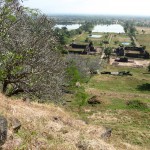
The complex, Wat Phou, was begun as a Hindu religious site because the mountain resembles the phallic or linga symbol for the Hindu god Shiva, and was considered particularly holy because a natural spring provided an abundant water supply out of the mountain to water the god figure in the upper temple, as well as supply the man-made rectangular barays or lakes at the base of the mountain. Not much remains of the oldest versions and the visible remains are mostly from the 11th and 12th century after power had shifted to Angkor. Later adaptations to Buddhism have been removed with restoration, except for the wryly smiling Buddha images placed in the temple at the top.
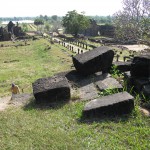
The wat was built in an orderly set of tiers and structures up the slope of the mountain, along a kilometer and a half east-west axis, each level appropriate for the different hierarchies of people involved in ceremonies here, and somewhat symmetrical from north to south. In the distance, on the Mekong, once sat the old city where the population lived.
It takes quite a long time to explore this place fully, even with someone telling you everything. Despite the early heat of a blazing sun, we spent two and a half hours walking the remnants and reconstructed buildings. But it was an enjoyable time, very instructive and also slow enough to appreciate the carvings and culture of this ancient civilization.

Near the bottom were two large decorated halls for possibly separate male and female celebratory functions, one north and one south, each being reconstructed by an archaeological team from France or India. The doorways still showed elaborate decorations and reliefs. The climb from bottom to top was energetic and awe inspiring.
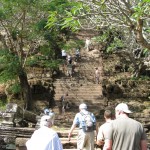
The most challenging part was the 77 narrow and high-rising steps in the later tiers; clearly, some visitors couldn’t handle them very well, either going up or down. But, as you rose, you moved deeper and deeper into the world of these people, with the crowning glory being the temple at the top together with the vista back onto the plain.

That temple was adorned with graceful bas-relief sculptures including panels celebrating Shiva and Vishnu, done in brilliantly rhythmic and lively fashion by the carvers of the Khmer.
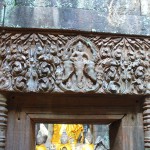
Around the temple were an array of curiosities, an elephant head cut into a massy boulder and a full-size image of a crocodile deeply dug into solid rock, which may or may not have been used to place a local woman for sacrifice. At the back, still dripped the sacred spring even after 2000 years, and we did anoint ourselves for good luck.
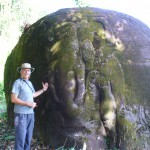
Back down on the plain, the small museum within the complex exhibited engaging and artistic highlights from stone objects found in the old city. The best were more carved friezes from buildings, Persian-looking lions, a bulbous buffalo that carried one of the Hindu gods, plus several reliefs that explained more about the gods and creatures. Though we’d been getting bits and pieces of stories about these figures, these explanations helped a lot. Finally, we realized that naga, the snake, represented the earthly material world and water, while its enemy, the everpresent garuda, transporter of Vishnu, represented the air and light. In Buddhist lore, naga rose to protect Buddha from rising waters, ostensibly demonstrating the compliance of the earthly with his ideals.
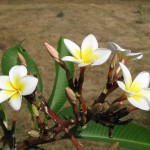
The trip was also successful for seeing the flower which is the symbol of Laos, the champa, a lovely white whorl of five petals with a light scent and a yellow tinted interior. They fell around us with the wind as if we were royalty ourselves.
To see more pictures from Laos, click here for the Laos itinerary page and the slideshow at the end.

